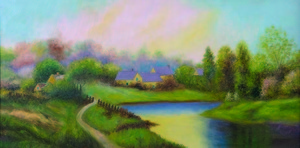

One of Anna Graybeal's landscapes. (Photograph by James H. Price)
Anna Graybeal was a practically perfect example of why the programs of the Great Depression were valuable at the purely individual and local level. Anna was a homemaker when these programs were started. She had graduated from Johnson County High School in Mountain City, Tenn., one of just two graduates that year, had married and taught elementary school until her children were born. Then she stayed home to care for them for some 20 years... until Annie Matney began to teach art classes on Wednesday afternoons.
These were not just any art classes. It was the 1930s, and they were part of the Works Progress Administration, established by President Franklin Roosevelt under the Great Depression's New Deal programs. Much of the work of the WPA had to do with employing men, many unskilled and all out of work, to supply the labor force for building bridges, roads and public buildings across America. But this was not all of the WPA's good works.
It had an artistic arm, called the Federal Art Project. Through it, legions of the nation's creative individuals were also employed to bring relief to the oppressed economies of communities around the nation, not to build bridges but to write musical scores that would appeal to the general public, produce plays for working class people to enjoy, assemble inventories of American art and design, and to paint public murals and art work for public buildings.
The Federal Art Project didn't only do things on a grand and professional scale, however. It also created community art centers that sought to bring art right down to the local and individual level, creating new audiences for the appreciation of art and perhaps inspiring new artists through art instruction for anyone who was interested.
Anna Graybeal was interested, and she was talented. She took Annie's afternoon art classes until Annie got married and moved to western North Carolina where she continued to teach art. Though Annie left, she had evidently done her work well, at least in Anna's case. Anna was a prolific painter, and her descendants have saved most of her oils. The one shown here is a landscape painted in soft pink, green, yellow, blue and brown and is reminiscent of village life in Europe during the 19th century. Perhaps Annie's painting classes used old master paintings as a model for her students' work.
There are probably many homes throughout Southwest Virginia and Northeast Tennessee that have paintings created through these community art centers by grandmothers, grandfathers or great-aunts and uncles. They may hang on the walls of living rooms today where they have been enjoyed by families for years ... little known examples of the Federal Art Project of the Great Depression.
Anna Graybeal, Artist is adapted from "Backcountry Makers: An Artisan History of Southwest Virginia & Northeast Tennessee." This is the 10th in a series of articles related to this new book by Betsy K. White. Featuring more than 200 color images, it is newly published by the University of Tennessee Press.
"Backcountry Makers" is White's second book on the history of the region's material culture. The first, "Great Road Style: the Decorative Arts Legacy of Southwest Virginia & Northeast Tennessee" was published in 2006 by the University of Virginia Press. "Backcountry Makers" is now available in Abingdon at Zazzy'Z Coffee House & Bookstore and at Heartwood: Southwest Virginia's Artisan Gateway or online from the University of Tennessee Press or Amazon.com.